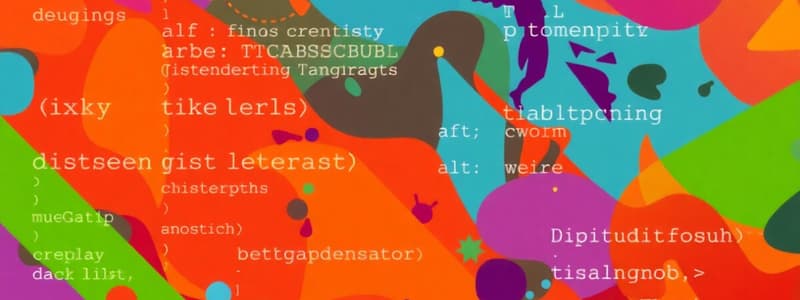Podcast
Questions and Answers
Which of the following best defines an algorithm?
Which of the following best defines an algorithm?
- A series of unstructured actions taken to solve various issues.
- A collection of data that needs processing to return results.
- A finite set of steps which provide a chain of action for solving a problem. (correct)
- An infinite set of steps that guide decision-making.
In the context of algorithms, what does 'breaking the solution into steps' help with?
In the context of algorithms, what does 'breaking the solution into steps' help with?
- Facilitating a clearer understanding of program logic. (correct)
- Complicating the logic of the program.
- Minimizing the need for inputs.
- Improving the accuracy of data.
What is the first step in creating an algorithm?
What is the first step in creating an algorithm?
- Identify the Processes
- Identify the Inputs (correct)
- Identify the Outputs
- Break the Solution into steps
Which of the following best characterizes the outputs of an algorithm?
Which of the following best characterizes the outputs of an algorithm?
What is a key difference between data and information in the context of algorithms?
What is a key difference between data and information in the context of algorithms?
What describes a program in computer programming?
What describes a program in computer programming?
What is the role of a compiler in programming?
What is the role of a compiler in programming?
Which of the following is NOT included in the first two generations of programming languages?
Which of the following is NOT included in the first two generations of programming languages?
What type of languages are classified under fourth-generation programming languages?
What type of languages are classified under fourth-generation programming languages?
Which of the following is an example of a fifth-generation programming language?
Which of the following is an example of a fifth-generation programming language?
Which statement best defines computer programming?
Which statement best defines computer programming?
Which generation of programming languages primarily focuses on database programming and scripting?
Which generation of programming languages primarily focuses on database programming and scripting?
What is a common misconception about algorithms in programming?
What is a common misconception about algorithms in programming?
Flashcards are hidden until you start studying
Study Notes
Program
- A program consists of instructions written in a programming language.
- Functions analogously to a recipe, featuring variables (ingredients) and statements (directions).
- Must be converted into machine language for a computer to process, accomplished by a compiler or interpreter.
Computer Programming
- Encompasses writing, testing, debugging, and maintaining source code.
- Source code is written in programming languages like C, C++, Java, and Perl.
Generations of Programming Languages
- First Generation (1GL): Machine languages, the most basic level of programming.
- Second Generation (2GL): Assembly languages used for kernels and hardware drives; still considered low-level.
- Third Generation (3GL): High-level languages like C, C++, Java, Visual Basic, and JavaScript.
- Fourth Generation (4GL): High-level languages resembling human language, used in database programming; examples include Perl, Python, Ruby, SQL, and MATLAB.
- Fifth Generation (5GL): Languages with visual programming tools, such as Mercury and Prolog.
Algorithm
- Defined as a finite set of steps providing a sequence of actions to solve a problem.
- Involves a step-by-step approach to finding a solution.
Steps to Create an Algorithm
- Identify Inputs: Determine what data is needed and how to obtain it.
- Identify Outputs: Specify the desired outputs and their format.
- Identify Processes: Understand how to manipulate data to yield meaningful results.
- Break the Solution into Steps: Simplify the logic and flow of the program.
Example of an Algorithm
- Establishing telephone communication follows a clear sequence of steps from dialing to call disconnection.
Simple Algorithm Example: Adding Two Numbers
- Step 1: Start.
- Step 2: Take two numbers.
- Step 3: Add the numbers.
- Step 4: Print the result.
- Step 5: Stop.
Important Definitions
- An algorithm is a "finite set of steps, which provide a chain of action for solving a problem."
Studying That Suits You
Use AI to generate personalized quizzes and flashcards to suit your learning preferences.



